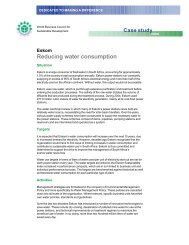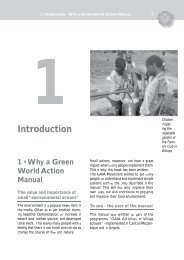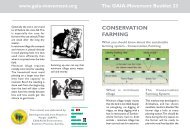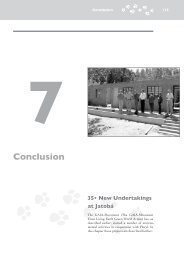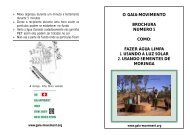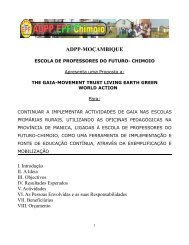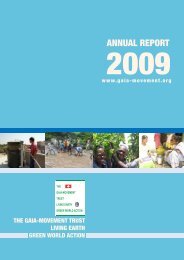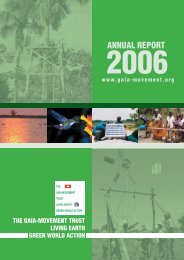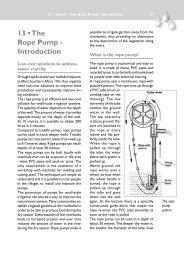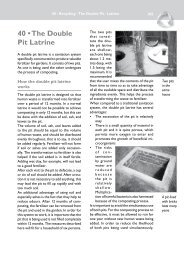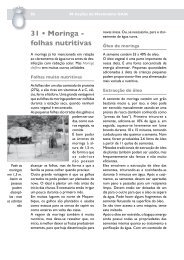Create successful ePaper yourself
Turn your PDF publications into a flip-book with our unique Google optimized e-Paper software.
<strong>What</strong> <strong>is</strong> <strong>an</strong> <strong>OPV</strong>?<br />
Open-pollinated varieties, or <strong>OPV</strong>s, refer to<br />
varieties of maize, sorghum or millet. <strong>OPV</strong>s are<br />
broad populations of m<strong>an</strong>y related pl<strong>an</strong>ts. <strong>The</strong><br />
pollination of the pl<strong>an</strong>ts in the seed field <strong>is</strong> not<br />
controlled, other th<strong>an</strong> growing the crop<br />
separate from other crops, <strong>an</strong>d so the seed of <strong>an</strong><br />
<strong>OPV</strong> <strong>is</strong> genetically diverse, but related. Thus,<br />
<strong>an</strong> <strong>OPV</strong> c<strong>an</strong> be thought of as <strong>an</strong> extended family<br />
with all members having similar related<br />
character<strong>is</strong>tics, yet there will still be some<br />
extremes within the family. Th<strong>is</strong> me<strong>an</strong>s that<br />
the crop of <strong>an</strong> <strong>OPV</strong> will not be highly uniform,<br />
like a hybrid. For example, the crop will vary<br />
in pl<strong>an</strong>t height, the color of the silks might<br />
show differences, <strong>an</strong>d the cobs will not all be of<br />
the same size <strong>an</strong>d shape, while the pl<strong>an</strong>ts will<br />
also mature at different times.<br />
Farmers who have grown maize <strong>an</strong>d retained<br />
the seed from year to year are growing <strong>OPV</strong>s of<br />
their own selection. <strong>The</strong>se are sometimes called<br />
“l<strong>an</strong>d races” <strong>an</strong>d they may be well adapted to<br />
the farmer’s environment. However, improved<br />
<strong>OPV</strong>s are available on the market. <strong>The</strong>se have<br />
been developed to be drought toler<strong>an</strong>t, d<strong>is</strong>ease<br />
res<strong>is</strong>t<strong>an</strong>t, <strong>an</strong>d well adapted to the areas for<br />
which they are recommended. <strong>The</strong>y are sold as<br />
certified open-pollinated seed with a<br />
particular name. <strong>The</strong>re may be m<strong>an</strong>y improved<br />
<strong>OPV</strong>s available <strong>an</strong>d thus the farmer needs to<br />
choose the one recommended for h<strong>is</strong>/her area.<br />
<strong>What</strong> are the adv<strong>an</strong>tages of growing <strong>OPV</strong>s?<br />
• <strong>The</strong> cost of the seed of <strong>OPV</strong>s <strong>is</strong> not as high<br />
as that of hybrid seed.<br />
• More money c<strong>an</strong> then used for buying<br />
fertilizer <strong>an</strong>d pesticides.<br />
• <strong>OPV</strong>s represent <strong>an</strong> economic option when<br />
hybrid seed <strong>an</strong>d fertilizer prices are high<br />
relative to the price of grain.<br />
• Seed c<strong>an</strong> be recycled (i.e., retained after<br />
harvest for pl<strong>an</strong>ting in the next season)<br />
with minimal loss in yield. Th<strong>is</strong> <strong>is</strong> unlike<br />
recycled hybrid seed, which suffers as<br />
much as 30 % loss in yield. Farmers who<br />
c<strong>an</strong>not readily obtain seed c<strong>an</strong> therefore<br />
maintain their own sources of seed.<br />
• If the farmer <strong>is</strong> situated in a low potential<br />
environment <strong>an</strong>d c<strong>an</strong>not afford extra inputs<br />
to justify the cost of hybrid seed, <strong>OPV</strong>s are<br />
a good alternative.<br />
• As <strong>OPV</strong>s are more variable in flowering<br />
dates <strong>an</strong>d peak drought stress <strong>is</strong> most severe<br />
during flowering, th<strong>is</strong> variation c<strong>an</strong> at<br />
times offer more stable yields th<strong>an</strong> do<br />
more uniformly flowering hybrids. Th<strong>is</strong> <strong>is</strong><br />
because some of the pl<strong>an</strong>ts might be better<br />
able to survive adverse conditions.<br />
<strong>The</strong> d<strong>is</strong>adv<strong>an</strong>tages of growing <strong>OPV</strong>s include:<br />
• <strong>The</strong> yield potential of <strong>OPV</strong>s <strong>is</strong> typically<br />
10-25% lower th<strong>an</strong> that of hybrid seed,<br />
although th<strong>is</strong> often depends on the<br />
m<strong>an</strong>agement <strong>an</strong>d production environment of<br />
the farm.<br />
• If a farmer <strong>is</strong> situated in <strong>an</strong> area with high<br />
yield potential <strong>an</strong>d has access to fertilizer<br />
<strong>an</strong>d pesticides, then growing <strong>OPV</strong>s will<br />
reduce h<strong>is</strong> profit margins. Th<strong>is</strong> <strong>is</strong> because<br />
h<strong>is</strong> potential yield will not be as high as<br />
when growing hybrids.<br />
• <strong>OPV</strong>s may not be uniform in color, maturity<br />
<strong>an</strong>d other pl<strong>an</strong>t character<strong>is</strong>tics, leading to<br />
less aesthetically pleasing harvests. Th<strong>is</strong><br />
could potentially impact the price of the<br />
grain if it <strong>is</strong> sold.<br />
• Th<strong>is</strong> lack of uniformity may lead to<br />
difficulties in the carrying out of certain<br />
operations such as harvesting, especially<br />
when using combine harvesters.<br />
Farmers who live far from retail shops c<strong>an</strong><br />
recycle seed from certified <strong>OPV</strong>s for a maximum<br />
of three years without signific<strong>an</strong>t yield loss if<br />
they are careful to avoid contamination of<br />
pollen from neighboring fields.<br />
When recycling open-pollinated varieties the<br />
following should be remembered.
• First, grow <strong>an</strong> <strong>OPV</strong> that <strong>is</strong> recommended for<br />
your area <strong>an</strong>d obtain certified seed from a<br />
reputable dealer.<br />
• M<strong>an</strong>age your fields well, practicing<br />
conservation agriculture, using m<strong>an</strong>ure or<br />
fertilizer or both, <strong>an</strong>d control weeds <strong>an</strong>d<br />
pests.<br />
• Grow your crop at least 100 meters away<br />
from other maize fields, or sow your maize<br />
three weeks earlier or later th<strong>an</strong> nearby<br />
crops, so that it flowers at a different time.<br />
In th<strong>is</strong> way you will ensure that<br />
unnecessary contamination of pollen does<br />
not occur.<br />
• If you c<strong>an</strong>not <strong>is</strong>olate by time or d<strong>is</strong>t<strong>an</strong>ce as<br />
outlined above then you should harvest<br />
from the middle of the field to minimize<br />
contamination <strong>an</strong>d the field should be at<br />
least about one hectare in size.<br />
• Inspect your field before flowering <strong>an</strong>d<br />
remove <strong>an</strong>y pl<strong>an</strong>ts that look very different<br />
from the others, especially if they are very<br />
short or very tall, or if they are d<strong>is</strong>eased.<br />
• When harvesting for seed, choose only the<br />
best cobs from the best looking pl<strong>an</strong>ts that<br />
are near the centre of the field. At least 500<br />
cobs should be harvested, <strong>an</strong>d harvesting<br />
should take place when the husks are dry.<br />
Select cobs that are uniform, free of d<strong>is</strong>ease<br />
<strong>an</strong>d have the desired grain quality.<br />
• <strong>The</strong> cobs should be shelled, dried in the sun<br />
<strong>an</strong>d then stored under appropriate<br />
conditions, i.e., in a dry, protected place.<br />
• Shelling should be carried out when the<br />
grain <strong>is</strong> dry. Th<strong>is</strong> <strong>is</strong> usually when the grain<br />
has reached 13 % mo<strong>is</strong>ture content. (To test<br />
th<strong>is</strong>, mix 100 seeds with one gram of salt<br />
<strong>an</strong>d leave in a sealed bottle. If after five<br />
minutes salt feels mo<strong>is</strong>t then cobs need more<br />
drying.)<br />
• Once the seed <strong>is</strong> dried to 13 % mo<strong>is</strong>ture it<br />
should be treated with insecticides <strong>an</strong>d<br />
fungicides against pests.<br />
• Seed should be stored in a cool, dry place,<br />
away from sunlight <strong>an</strong>d not used for<br />
consumption by <strong>an</strong>imals or hum<strong>an</strong>s. Ensure<br />
that rodents do not have access to the seed,<br />
as they c<strong>an</strong> destroy the seed in a very short<br />
space of time.<br />
• <strong>OPV</strong>s may be recycled for 3 seasons before<br />
buying new certified seed.<br />
Seed production of open-pollinated varieties<br />
<strong>The</strong>re are three stages in the production of seed.<br />
<strong>The</strong> first stage <strong>is</strong> the production of breeder’s (or<br />
pre-basic) seed. Th<strong>is</strong> <strong>is</strong> carried out by the<br />
originator of the variety, usually called the<br />
breeder. Breeder’s seed <strong>is</strong> produced in small<br />
plots where a breeder c<strong>an</strong> monitor the pl<strong>an</strong>ts to<br />
ensure that as m<strong>an</strong>y off-types as possible are<br />
eliminated.<br />
<strong>The</strong> second stage <strong>is</strong> the production of<br />
foundation or basic seed. <strong>The</strong> foundation seed<br />
<strong>is</strong> produced by breeders or seed comp<strong>an</strong>ies <strong>an</strong>d<br />
represents the first increase in the breeder’s<br />
seed, in order to obtain sufficient qu<strong>an</strong>tities for<br />
certified seed production.<br />
<strong>The</strong> third stage <strong>is</strong> the last stage in seed<br />
multiplication, <strong>an</strong>d <strong>is</strong> called certified seed<br />
production. Seed comp<strong>an</strong>ies contract farmers to<br />
produce certified seed. Farmers need to first<br />
reg<strong>is</strong>ter with the government <strong>an</strong>d the seed<br />
services as a seed grower to be able to grow<br />
certified seed. <strong>The</strong> seed <strong>is</strong> grown under<br />
specified conditions to ensure st<strong>an</strong>dards. Before<br />
being labeled <strong>an</strong>d sold as certified seed,<br />
laboratory tests are carried out to ensure that<br />
the seed <strong>is</strong> viable <strong>an</strong>d healthy <strong>an</strong>d meets the<br />
quality as described on the label.<br />
Th<strong>is</strong> fact sheet was prepared as part of the IRRI-CIMMYT alli<strong>an</strong>ce - Cereal Knowledge B<strong>an</strong>k<br />
(knowledgeb<strong>an</strong>k.cimmyt.org) • Developed with input from A.L.MacRobert, P.Kosina, J. Jones • 2007



